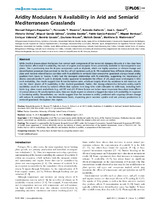Mostrar el registro sencillo del ítem
Aridity Modulates N Availability in Arid and Semiarid Mediterranean Grasslands
| dc.contributor.author | Delgado-Baquerizo, Manuel | |
| dc.contributor.author | Maestre Gil, F.T. | |
| dc.contributor.author | Gallardo, Antonio | |
| dc.contributor.author | Quero, José L. | |
| dc.contributor.author | Ochoa Esteban, V. | |
| dc.contributor.author | García-Gómez, Miguel | |
| dc.contributor.author | Escolar Miguel, C. | |
| dc.contributor.author | García-Palacios, Pablo | |
| dc.contributor.author | Berdugo Vega, M. | |
| dc.contributor.author | Valencia, Enrique | |
| dc.contributor.author | Gozalo, Beatriz | |
| dc.contributor.author | Noumi, Zouhaier | |
| dc.contributor.author | Derak, Mchich | |
| dc.contributor.author | Wallenstein, Matthew D. | |
| dc.date.accessioned | 2017-12-01T07:57:23Z | |
| dc.date.available | 2017-12-01T07:57:23Z | |
| dc.date.issued | 2013 | |
| dc.identifier.uri | http://hdl.handle.net/10396/15619 | |
| dc.description.abstract | While much is known about the factors that control each component of the terrestrial nitrogen (N) cycle, it is less clear how these factors affect total N availability, the sum of organic and inorganic forms potentially available to microorganisms and plants. This is particularly true for N-poor ecosystems such as drylands, which are highly sensitive to climate change and desertification processes that can lead to the loss of soil nutrients such as N. We evaluated how different climatic, abiotic, plant and nutrient related factors correlate with N availability in semiarid Stipa tenacissima grasslands along a broad aridity gradient from Spain to Tunisia. Aridity had the strongest relationship with N availability, suggesting the importance of abiotic controls on the N cycle in drylands. Aridity appeared to modulate the effects of pH, plant cover and organic C (OC) on N availability. Our results suggest that N transformation rates, which are largely driven by variations in soil moisture, are not the direct drivers of N availability in the studied grasslands. Rather, the strong relationship between aridity and N availability could be driven by indirect effects that operate over long time scales (decades to millennia), including both biotic (e.g. plant cover) and abiotic (e.g. soil OC and pH). If these factors are in fact more important than short-term effects of precipitation on N transformation rates, then we might expect to observe a lagged decrease in N availability in response to increasing aridity. Nevertheless, our results suggest that the increase in aridity predicted with ongoing climate change will reduce N availability in the Mediterranean basin, impacting plant nutrient uptake and net primary production in semiarid grasslands throughout this region. | es_ES |
| dc.format.mimetype | application/pdf | es_ES |
| dc.language.iso | eng | es_ES |
| dc.publisher | Public Library of Science | es_ES |
| dc.rights | https://creativecommons.org/licenses/by-nc-nd/4.0/ | es_ES |
| dc.source | PLoS ONE 8(4): e59807 (2013) | es_ES |
| dc.subject | Ecosystems | es_ES |
| dc.subject | Climate change | es_ES |
| dc.subject | Edaphology | es_ES |
| dc.subject | Grasslands | es_ES |
| dc.subject | Nitrates | es_ES |
| dc.subject | Depolymerization | es_ES |
| dc.subject | Rain | es_ES |
| dc.subject | Mediterranean Basin | es_ES |
| dc.title | Aridity Modulates N Availability in Arid and Semiarid Mediterranean Grasslands | es_ES |
| dc.type | info:eu-repo/semantics/article | es_ES |
| dc.relation.publisherversion | http://dx.doi.org/10.1371/journal.pone.0059807 | es_ES |
| dc.relation.projectID | info:eu-repo/grantAgreement/EC/FP7/242658 (BIOCOM) | es_ES |
| dc.relation.projectID | Gobierno de España. CGL2010-21381 | es_ES |
| dc.rights.accessRights | info:eu-repo/semantics/openAccess | es_ES |

